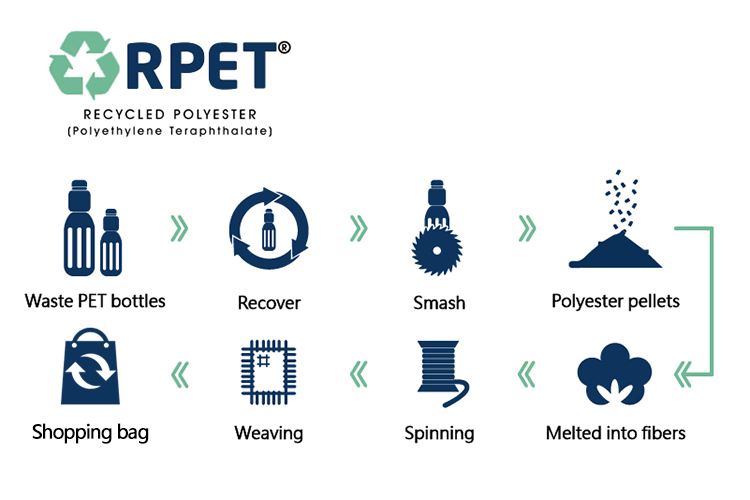The difference between RPET fabric and ordinary polyester fabric is simply that the source of fabric yarn is different.
Recycled PET fabric
RPET fabric is a new type of environmentally friendly recycled fabric, called Recycled PET Fabric in English, also known as recycled PET fabric. Its yarn is extracted from recycled mineral water bottles and cola bottles, also commonly known as cola bottle environmental protection cloth.
Because it is a new type of green recycled and environmentally friendly fabric, its low-carbon source has made great contributions to saving oil resources and protecting the ecological environment. Therefore, it is very popular abroad, especially in developed countries in Europe and America, and is widely used in suspenders, shirts, skirts, children’s clothing, silk scarves, cheongsam, ties, handkerchiefs, home textiles, curtains, pajamas, bows, gift bags, sleeves, fashion umbrellas, Pillowcases, throw pillows, etc.
Ordinary polyester fabric
As we all know, the yarn of ordinary polyester fabric is extracted from petroleum
Ordinary polyester fabric: that is, ordinary polyester (POLY), its chemical name is polyethylene terephthalate (PET), its tensile breaking strength and tensile breaking elongation are higher than those of cotton fiber, and it has good Heat resistance and thermal stability. Because of its many excellent properties, it is widely used in clothing, home textiles, decoration, and industrial supplies. Its rapid development speed and high output are known as “the crown of chemical fibers”.
The difference between recycled polyester and ordinary polyester
different performance
1. The strength and other properties of recycled polyester fibers are poor.
2. The strength and other properties of polyester fiber are relatively good.
different raw materials
1. Recycled polyester is re-granulated with recycled materials (PET bottle flakes, foam materials, etc.), and then drawn into fibers.
2. Polyester is made of chemical raw materials PTA and MEG polymerized and drawn into fibers.
Polyester yarn refers to the yarn spun from polyester as raw material. Polyester is a kind of fiber made by spinning a polymer. At present, it mostly refers to the fiber produced from ethylene phthalate as raw material. English name “polyethylene terephthalate” abbreviation, referred to as “PET” fiber. Commonly known as polyester in our country.
Regenerated polyester staple fiber is made of polyester fabric, waste polyester bottle flakes, spinning waste silk, foam material and pulp block as raw materials. Filament, winding, bunching, drawing, crimping, relaxation heat setting, and cutting to form polyester staple fibers of different lengths.
Compared with the two: environmentally friendly polyester not only has the advantages of ordinary polyester, but also tends to the concept of green environmental protection. More suitable for our customers.
Characteristics of polyester
1. High strength and toughness. The short fiber strength is 2.6 to 5.7 cN/dtex, and the high tenacity fiber is 5.6 to 8.0 cN/dtex.
Due to its low hygroscopicity, its wet strength is basically the same as its dry strength. The impact strength is 4 times higher than that of nylon and 20 times higher than that of viscose fiber.
2. Good elasticity. The elasticity is close to that of wool, and it can almost fully recover when the elongation is 5% to 6%. The wrinkle resistance exceeds other fibers, that is, the fabric does not wrinkle and has good dimensional stability. Polyester fabric has high strength and elastic recovery ability. Therefore, it is strong and durable, wrinkle-resistant and iron-free.
3. Heat-resistant polyester is made by melt-spinning method, and the formed fibers can be heated and melted again, and belong to thermoplastic fibers.
The melting point of polyester is relatively high, and the specific heat capacity and thermal conductivity are relatively small, so the heat resistance and thermal insulation of polyester fibers are higher. Is the best of synthetic fibers.
4. Good thermoplasticity and poor melting resistance. Due to the smooth surface of polyester and the close arrangement of internal molecules, polyester is the most heat-resistant fabric in synthetic fabrics. It has thermoplastic properties and can be made into pleated skirts with long-lasting pleats.
At the same time, polyester fabric has poor melting resistance, and it is easy to form holes when encountering soot, sparks, etc. Therefore, try to avoid contact with cigarette butts, sparks, etc. when wearing.
5. Good wear resistance. The abrasion resistance is second only to the nylon with the best abrasion resistance, and it is better than other natural fibers and synthetic fibers.
6. Good light resistance. Lightfastness is second only to acrylic. The light fastness of polyester fabric is better than that of acrylic fiber, and its light fastness is better than that of natural fiber fabric. Especially the light fastness behind the glass is very good, almost on par with acrylic.
7. Corrosion resistance. Resistant to bleaches, oxidants, hydrocarbons, ketones, petroleum products and inorganic acids. Dilute alkali resistance, not afraid of mildew, but hot alkali can make it decompose. It also has strong anti-acid and alkali resistance and anti-ultraviolet ability.
8. Poor dyeability, but good color fastness, not easy to fade. Because there is no specific dyeing group on the polyester molecular chain, and the polarity is small, it is difficult to dye, the dyeability is poor, and the dye molecules are not easy to enter the fiber.
9. It has poor hygroscopicity and feels stuffy when wearing it. At the same time, it is easy to carry static electricity and contaminate dust, which affects the appearance and comfort.
However, it is very easy to dry after washing, and the wet strength hardly decreases, and it does not deform. It has good wash and wear performance.
